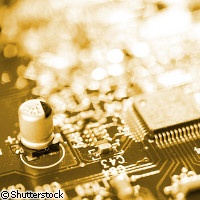Apr 17 2009
Researchers in Germany and Canada have developed a new technique called ballistic spin resonance that 'flips the spin' of unpaired electrons without using oscillating fields, which are cumbersome to generate on microchips. The innovative method, published in the journal Nature, is a step forward for controlling spin in semiconductors and has implications for quantum computing.

Scientists have been studying the way electrons spin for approximately 70 years. Electron spin resonance describes the flipping of spin in unpaired electrons (also called radicals). Inducing electron spin resonance using high-frequency magnetic fields has made the study of quantum mechanics possible. It is a valuable tool because the magnetic field can be used to control transitions between the spin state of unpaired electrons.
However, spin can also be induced using high-frequency electric fields in certain materials; the oscillation of the electrons itself creates a magnetic field that can act on the electrons' spin. Previous studies using external electric fields have been successful in flipping spins in a number of materials, including two-dimensional gases of electrons and 'quantum dots'. The problem is that oscillating fields are actually cumbersome to generate on a chip.
In this latest research, Dr Sergey Frolov of the University of British Columbia in Canada and colleagues in Germany took an original approach to the problem, hoping to manipulate spins without using an oscillating field. Their method was successful in producing the effect using a static field, which is highly desirable for electronic applications. Follow-up experiments confirmed the robustness of their technique.
The new 'ballistic spin resonance' involves making electrons bounce back and forth in the tiny channels of a two-dimensional semiconductor. Spin resonance is achieved using the magnetic field that is produced as a by-product of the interaction between the electrons' spin and their orbit. The repeated bouncing of the electrons off the channel walls effectively makes the magnetic field oscillate. The frequency of this oscillation happens to be valuable for spin-resonance applications.
The drawback of the method is that, while it manages to flip the electrons, it does so in a random way; the spins can't be manipulated into a specific orientation. This might be because impurities generated by the electrons stick to the channel walls and make the bouncing path too bumpy - the electrons all come off the walls at different angles. Future studies will use even cleaner materials, and will also incorporate electron-focusing techniques that will enable the researchers to better define the bouncing angle and frequency.
In an accompanying commentary, Dr Lieven Vandersypen of Delft University of Technology in the Netherlands notes: 'In the future, one could imagine applying the authors' technique of flipping spins to entire solid-state electronic circuits in which information is encoded in the spin state of the electrons. This is the vision of the field of spintronics, which has already led to discoveries such as "giant magnetoresistance" and the subsequent miniaturisation of hard-disk drives.'
Source: Cordis